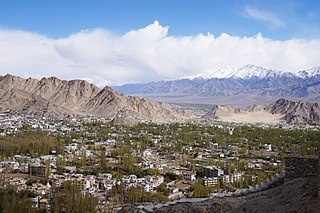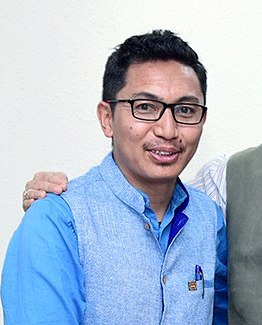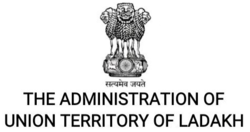
Ladakh is a region administered by India as a union territory and constitutes an eastern portion of the larger Kashmir region that has been the subject of a dispute between India and Pakistan since 1947 and India and China since 1959. Ladakh is bordered by the Tibet Autonomous Region to the east, the Indian state of Himachal Pradesh to the south, both the Indian-administered union territory of Jammu and Kashmir and the Pakistan-administered Gilgit-Baltistan to the west, and the southwest corner of Xinjiang across the Karakoram Pass in the far north. It extends from the Siachen Glacier in the Karakoram range to the north to the main Great Himalayas to the south. The eastern end, consisting of the uninhabited Aksai Chin plains, is claimed by the Indian Government as part of Ladakh, but has been under Chinese control.

Leh is a city in the Indian Union territory of Ladakh. It is the largest city and the joint capital of Ladakh. Leh, located in the Leh district, was also the historical capital of the Kingdom of Ladakh. The seat of the kingdom, Leh Palace, the former residence of the royal family of Ladakh, was built in the same style and about the same time as the Potala Palace in Tibet. Since they were both constructed in a similar style and at roughly the same time, the Potala Palace in Tibet and Leh Palace, the royal residence, are frequently contrasted. Leh is at an altitude of 3,524 m (11,562 ft), and is connected via National Highway 1 to Srinagar in the southwest and to Manali in the south via the Leh-Manali Highway.

Kargil district is a district in Indian-administered Ladakh in the disputed Kashmir-region. It is one of the two districts comprising the Indian-administered union territory of Ladakh. The district headquarters are in the city of Kargil. The district is bounded by the Indian-administered union territory of Jammu and Kashmir to the west, the Pakistani-administered administrative territory of Gilgit–Baltistan to the north, Ladakh's Leh district to the east, and the Indian state of Himachal Pradesh to the south. Encompassing three historical regions known as Purig, Dras and Zanskar, the district lies to the northeast of the Great Himalayas and encompasses the majority of the Zanskar Range. Its population inhabits the river valleys of the Dras, Suru, Wakha Rong, and Zanskar.

Leh district is a district in Indian-administered Ladakh in the disputed Kashmir-region. Ladakh is an Indian-administered union territory. With an area of 45,110 km2, it is the second largest district in the country, second only to Kutch. It is bounded on the north by Gilgit-Baltistan's Kharmang and Ghanche districts and Xinjiang's Kashgar Prefecture and Hotan Prefecture, to which it connects via the historic Karakoram Pass. Aksai Chin and Tibet are to the east, Kargil district to the west, and Lahul and Spiti to the south. The district headquarters is in Leh. It lies between 32 and 36 degree north latitude and 75 to 80 degree east longitude.

Kargil or Kargyil is a town in Indian-administered Ladakh, neighbouring the disputed Kashmir region. It is the joint capital of Ladakh, an Indian-administered union territory in the Trans-Himalaya. It is also the administrative capital of the Kargil district. It is the second-largest urban centre in Ladakh after Leh. Kargil is located 204 kilometres (127 mi) east of Srinagar in Jammu and Kashmir, and 234 kilometres (145 mi) to the west of Leh. It is situated on the bank of the Suru River near its confluence with the Wakha river, the latter providing the most accessible route to Leh.

Ladakh has a long history with evidence of human settlement from as back as 9000 b.c. It has been a crossroad of high Asia for thousands of years and has seen many cultures, empires and technologies born in its neighbours. As a result of these developments Ladakh has imported many traditions and culture from its neighbours and combining them all gave rise to a unique tradition and culture of its own.

The Ladakh Autonomous Hill Development Council, Leh is one among the two Autonomous District Council of Ladakh Union Territory. LAHDC Leh administers the Leh district of Ladakh, India.
Ladakh Union Territory Front (LUTF) was formed in 2002 as a conglomerate of political parties in Ladakh in India.

A union territory is a type of administrative division in the Republic of India. Unlike the states of India, which have their own governments, union territories are federal territories governed, in part or in whole, by the Union Government of India. There are currently eight union territories in India: Andaman and Nicobar Islands, Chandigarh, Dadra and Nagar Haveli and Daman and Diu, Delhi (NCT), Jammu and Kashmir, Ladakh, Lakshadweep and Puducherry.

The Government of Jammu and Kashmir is the governing authority of the Indian union territory of Jammu and Kashmir and its two divisions and 20 districts.

Ladakh Autonomous Hill Development Council, Kargil, is one among the two Autonomous District Councils of Ladakh union territory. LAHDC Kargil administers the Kargil District of Ladakh, India.
Haji Ghulam Hassan Khan is an Indian politician from the union territory of Ladakh.
Chering Dorjay is an Indian politician and was a member of the Bharatiya Janata Party. Dorjay was a member of the Jammu and Kashmir Legislative Council from the Assembly Kashmir (Ladakh). He was Minister for Cooperatives and Ladakh Affairs in Jammu and Kashmir till 19 June 2018.

Jamyang Tsering Namgyal is an Indian politician and Member of Parliament from Ladakh, India's largest parliamentary seat geographically. Namgyal was elected, on 9 November 2018, to be the youngest and 8th Chief Executive Councillor (CEC) of Ladakh Autonomous Hill Development Council, Leh. He belongs to the Bharatiya Janata Party (BJP).

Ladakh Police is the police agency responsible for law enforcement and investigations within the Union territory of Ladakh, India. It came into existence on 31 October 2019.

The Emblem of Ladakh is the symbol used to represent the government of Ladakh, a region in the northern part of the Indian subcontinent currently administered by India as a union territory. It was adopted following the creation of the union territory of Ladakh on 31 October 2019.

Politics of Ladakh is exercised within democratic setup of the Indian-administered union territory of Ladakh. Major power centres are Ladakh Autonomous Hill Development Council, Leh and Ladakh Autonomous Hill Development Council, Kargil alongside Ladakh Lok Sabha constituency. Indian National Congress and Bharatiya Janata Party are major political parties. Ladakhi religious organisations like Ladakh Buddhist Association, Imam Khomeni Memorial Trust and Anjuman-e-Jamiat-ul-Ulama Asna Asharia have major influences as well.

The following outline is provided as an overview of and topical guide to Ladakh:
Elections were held in October 2023 for the 26 seats of Ladakh Autonomous Hill Development Council, Kargil. This was also the first election conducted in the union territory of Ladakh since its split from Jammu and Kashmir in 2019.














